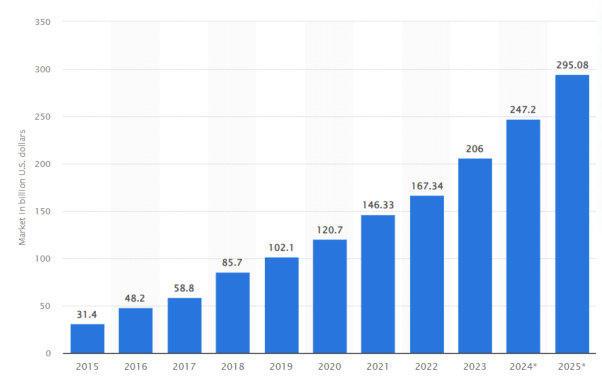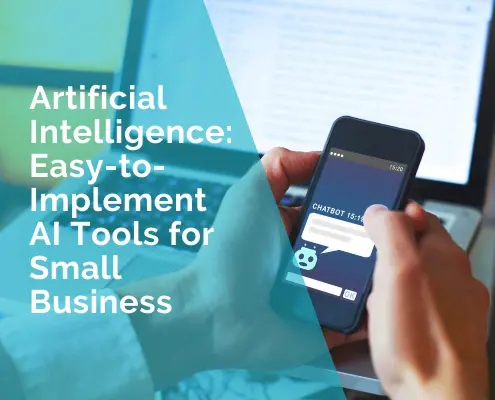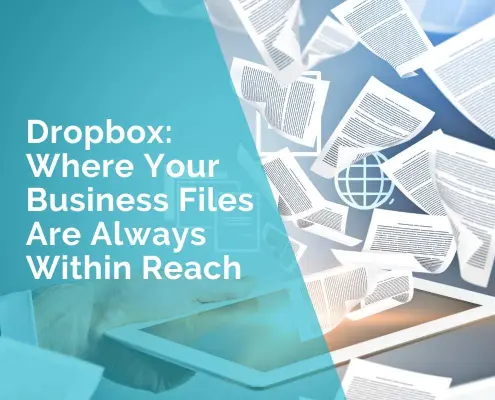7 Best SaaS Solution Types for Startups & Small Businesses in 2024
The industry of software as a service (SaaS) is thriving. According to Statista’s data analysis the SaaS market could accrue $295 billion by 2025. This increased momentum stems from the rapid adoption of cloud applications by both startups and small enterprises.
There are numerous perks from SaaS tools, like their ability to be scaled and their price efficiency. By minimizing the need for major investments at the outset, startups and small firms can use powerful enterprise-level solutions, which gives them a chance to compete with bigger firms.
With many SaaS products on the market, how will you determine which one to go with? Your startup or small business needs SaaS solutions specific to your goals and requirements.
This article will discuss the seven most popular and helpful SaaS solution types that small companies should consider investing in over the next couple of years.

1. Customer Relationship Management (CRM)
A good CRM solution can make or break your startup’s success in sales and customer relationships. CRMs help manage key customer data and interactions across channels to improve relationships and boost conversions.
According to Demandsage, over 91% of businesses with 11-50 employees use CRM systems today. And this number will only rise over the next few years as CRMs become more affordable and customizable.
Key Benefits
- Centralized customer database
- Sales automation
- Marketing campaign management
- Lead tracking
- Reporting and analytics
- Improved team collaboration
Some popular CRM SaaS tools suitable for early-stage startups include HubSpot CRM, Zoho CRM, Freshsales, and more. Select a solution or custom SaaS development agency that aligns with your budget and offers just the right features you need. Avoid overcomplicated products that will take too long to onboard and learn.
2. Project Management
Handling various projects with small teams often turns into disorder without organized systems. Systems for managing projects enable task assignment and help teams connect while keeping track of efforts in a remote setting.
Tools for project management boost the prioritization of tasks and ensure responsibility among tasks, causing over-project completion and joyful clients.
Key Benefits
- Advanced task management
- Customizable workflows
- Progress tracking
- Timeline management
- Resource allocation
- Reporting
Top project management SaaS options, such as Asana, Trello, Teamwork, Basecamp, and more, provide excellent value for money. When evaluating options, look for simple and intuitive interfaces.
3. Business Intelligence and Analytics
In our data-driven world, analytics should drive every business decision – no matter how small your company is. Business intelligence (BI) SaaS solutions help visualize, analyze and extract powerful insights from your startup’s data.
Robust reporting and analytics are no longer just a ‘nice-to-have’. They’re a must-have to boost efficiency, identify problem areas and accelerate growth. Modern BI tools democratize data access, allowing your entire company to leverage analytics.
Key Benefits
- Data warehousing
- Interactive reporting
- Real-time analytics
- Customizable dashboards
- Data integration
- Scalability
Top BI SaaS platforms like Grow, Domo, Tableau, Looker, Sisense, and more now have tiered pricing suitable even for 5-10 people teams. Don’t ignore data – choose a platform that makes analytics accessible without needing an IT team.
4. Accounting and Finance
Managing accounts, finances, taxes, payments, and compliance gets very painful without the right tools. Finance SaaS platforms streamline and automate routine accounting tasks so startups can stay compliant and keep overhead costs low.
Integrated financial systems also improve accuracy and transparency across your business. Managing accounts becomes faster and easier, allowing you to focus on big-picture growth.
Key Benefits
- Automated accounting
- Tax management
- Compliance
- Invoicing
- Expense tracking
- Bank reconciliations
- Financial reporting
Leading accounting SaaS platforms like Freshbooks, Sage Accounting, NetSuite, Xero, and QuickBooks Online offer varying pricing tiers for early-stage businesses. Select one that best matches your business model and complexity.
5. Human Resource Management (HRM)
Your startup’s most valuable asset is your team. An HR SaaS system helps manage the employee lifecycle – from hiring to offboarding. With a unified platform, you can streamline key workflows like recruiting, onboarding, payroll, benefits administration, performance management, and more.
Centralizing HR operations improves organization, compliance, employee experience and productivity, allowing small teams to perform above their weight.
Key Benefits
- Applicant tracking
- Onboarding
- Payroll
- Time and attendance
- Performance management
- Learning management
- Succession planning
Choose from top HRM SaaS solutions like BambooHR, Gusto, Zenefits, or Workday Adaptive HCM at price points matching your team size. Don’t wait until you have over 100+ employees to invest in HR technology.
6. Marketing Automation
Marketing remains one of the top 3 expenses for most startups today. Without automation, managing campaigns, social media, emails, web analytics, and sales integration becomes an uphill task.
Marketing automation SaaS brings all these functions under one platform to streamline lead generation and conversions. These tools help track ROI on campaigns, reduce manual tasks, and deliver personalized engagement.
Key Benefits
- Campaign creation
- Lead scoring
- Web analytics
- Landing page builder
- Email marketing
- Sales integration
- Reporting
HubSpot Marketing Hub, Ontraport, Mailchimp, Constant Contact, and SendinBlue are some of the most popular marketing automation SaaS solutions suitable for lean teams. Identify which marketing channels you will invest in and at what scale to shortlist tools.
7. Information Technology (IT) Management
As a fast-growing startup, your web infrastructure, data security, remote access, and IT systems need to evolve rapidly, too. Setting up servers and tools in-house requires significant capital investment and technical skills.
IT management SaaS solutions help small businesses skip this hassle by providing on-demand access to enterprise-grade IT infrastructure. These tools manage networks, endpoints, access controls, security protocols, business applications, and more.
Key Benefits
- Cloud infrastructure
- Endpoint monitoring
- Network security
- Identity access management
- Business continuity
- Remote access
- Helpdesk ticketing
Top IT management SaaS vendors like Okta, JumpCloud, VMware Workspace ONE, and ManageEngine ServiceDesk Plus offer tailored solutions for modern remote-first workforces. Evaluate them before your needs become too complex.
How to Choose the Right SaaS Solutions
Not all SaaS products are made equal. With new solutions launching every single day across categories, the paradox of choice is very real.
A perfect SaaS combination for your organization must tackle urgent issues without introducing extra costs or confusion. Here is a step-by-step process to pick the right SaaS solutions:
1. Understand Current Workflows
In detail assess how your teams currently complete essential activities and workflows. Highlight areas of strength and weakness for each work area including sales and marketing.
This process provides an understanding of the urgent issues to tackle before jumping into fresh systems.
2. Define Requirements
Following the challenges you noticed earlier establish precise expectations for each department. Identify key components and features as well as implementation times and support needs regarding new SaaS products.
Be careful with general criteria that result in later overloading of features. Conclude discussion with top priorities in advance of demos.
3. Create Shortlist
Analyze the domain and form a three to five strong candidate list for SaaS tools in every category. Research the use of peer advice and customer evaluations to determine how well software fits your needs.
Check the requirements with the features offered. This technique clears away individual preferences and directs your attention toward those tools that verify all standards.
4. Prioritize Budget
To close the year’s budgeting process effectively a re-evaluation of SaaS funding is necessary depending on the expected profits from every tool. Consider the essentials and accessories based on your total spending.
When your needs change with time, align them with present needs instead of wasting time on what may become obsolete. The goal is quick wins first.
Key SaaS Buying Best Practices
Making the right SaaS decisions gets easier when you keep certain best practices in mind during buying journeys:
Start Small, Scale Fast
When you first roll out a project, go for simple SaaS applications, even if they are limited-packed, instead of choosing complex tools that demand extensive training. If your demands increase, you will have the option to modify or replace your products.
Integrations Matter
Assess which third-party applications your selected SaaS products connect with to create cohesive processes. Examples of desired platforms provide APIs and pre-assembled connectors to enable seamless interaction among vital systems.
Data Ownership Is Key
Your business data represents your most valuable resource. Read the terms beforehand to confirm that data belongs to you so you can export when required. Stay away from SaaS agreements that limit your abilities to move or switch products.
Calculate Total Cost of Ownership
Analyze expenses above monthly expenses to include setup fees, training costs, customizations and other amounts that elevate TCO over time. Analyze the lasting costs rather than only looking at temporary promotions.
Verify Security & Compliance
Before adding applications handling sensitive data in business contexts, compliance and backup protocols must be checked. Protect customer trust by avoiding breaches that compromise data.
Request Implementation Support
For SaaS effectiveness, it is essential to do onboarding effectively. Outside the DIY setup, look for vendor resources for customized implementation specific to your workflows. Predicament: do not partake in urgent software shifting.
Invest in Training
The outcome of new SaaS solutions largely depends on user engagement. Add to device benefits with customized training sessions for your team. Teach them to make the most of the features from their first day.
Key Takeaways
Here are the key points to remember about choosing the right SaaS solutions:
- Review customized SaaS for primary functions, including CRM and marketing.
- Addressing serious problems should be your top priority instead of a desirable function when choosing platforms.
- Analyze options according to your defined fundamental needs.
- Apply for free trials and gain insights from peers to evaluate the usefulness of real workflows.
- Develop a foundation of necessary low-cost equipment and grow in response to expanding requirements.
- Analyze the integration connectivity and overall protection plans, plus the agreements and onboard training options as you purchase tools.
- Put effort into supporting change and teaching for the best user buy-in.
Starting new businesses can now use premium technology systems thanks to the SaaS movement. Telefonkan nicht die Umsetzung eines digitalen Wandels – profitiere heute von der Cloud um deine Prozesse zu vereinfachen. Act decisively to select solutions that help your developing teams achieve strength and success.
***
Alice Larionova












